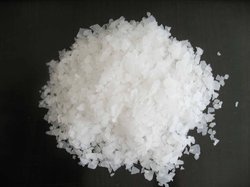Sodium nitrate
|
SYNONYMS |
Chile saltpeter; cubic or soda nitre EMPIRICAL FORMULA NaNO3 MOLECULAR WEIGHT 85.00 |
|
DEFINITION |
Sodium nitrate after drying contains not less than 99.0% of NaNO3 and conforms to the following specifications. |
|
DESCRIPTION |
Clear, colorless, odourless, transparent crystals, or white granules or powder. Deliquescent in moist air.
|
|
USE |
As an antimicrobial preservative and colour fixative in meat, fish and cheese products. Often need In combination with nitrites. |
|
IDENTIFICATION TESTS
|
|
|
Solubility: Water: |
1 g is soluble in 1.1 ml
|
|
Ethanol: |
1 g is soluble in 125 ml Glycerol: Slightly soluble Sodium nitrate yields with uranyl zinc acetate TS a golden-yellow precipitate, which forms after several minutes' agitation. Sodium nitrate yields with uranyl zinc acetate TS a golden-yellow precipitate, which forms after several minutes' agitation.
Brownish red fumes are evolved when sodium nitrate is heated with sulfuric acid and metallic copper |
|
PURITY TESTS
|
Loss on drying: Not more than 2% after drying at 105°C for 4 hours |
|
pH of a 5% solution |
Dissolve 10 g in 200 ml of carbon dioxide- and ammonia-water, the pH of this solution is between 5.5 and 8.3. |
|
Arsenic |
Not more than 3 mg/kg. Lead: Not more than 10 mg/kg. |
|
Nitrite |
Not more than 1000 mg/kg. |
|
|
Dissolve 1 g in 50 ml of carbon dioxide- and ammonia-free water, add 2 drops of dilute ammonia TS, and filter if necessary through paper into a 100-ml volumetric fleck. Add 10 ml of dilute acetic acid TS, shake the mixture, and allow to stand for 5 minutes. Any colour produced is not darker than that of a complete blank to which 1 ml of nitrite standard TS is added.
|
|
Heavy metals |
Not more than 20 mg/kg. Dissolve 3 g in water and dilute to 30 ml. Adjust 20 ml of this solution to a pH between 3.0 and 4.0 and dilute with water to 40 ml. To the remaining 10 ml of sample solution add water to make 35 ml, add a volume of standard lead TS equivalent to 0.02 mg of lead and adjust to a pH between 3.0 and 4.0 and dilute to 40 ml. To each solution add 10 ml of hydrogen sulfide TS, mix, transfer to 50-ml Nessler tubes and observe after 10 minutes. The colour of the test solution should be no darker than that of the solution containing the standard lead solution.
|
|
ASSAY
|
Weigh 1.000 g of sodium nitrate previously dried at 105°C for 4 hours into the flask of an ammonia distillation apparatus. Add 10 g of
Devarda's Alloya and 25 ml of N
sulfuric acid and allow the flask. to stand, protected from ammonia in the atmosphere, for 1 hour. Add 100 ml of a solution of sodium hydroxide (15 in 100), connect the flask to the remainder of the apparatus and distil 100 ml, collecting the distillate under the surface of 25.0 ml of N hydrochloric acid.
Rinse the condenser into the receiving flask, add methyl red methylene
blue TS and titrate the excess acid with N
sodium hydroxide. |
|
|
(25-x) %NaNO3 = × 8.5 w
|


